Royal Netherlands Navy
The Royal Netherlands Navy (Dutch: Koninklijke Marine) is the naval force of the Kingdom of the Netherlands.[2] Its origins date back to the Eighty Years' War (1568–1648), the war of independence from the House of Habsburg who ruled over the Habsburg Netherlands.
| Royal Netherlands Navy | |
|---|---|
| Koninklijke Marine | |
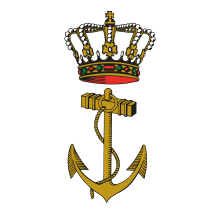 Emblem of the Royal Netherlands Navy | |
| Founded | 8 January 1488 |
| Country | |
| Branch | Armed Forces of the Netherlands |
| Type | Green-water navy |
| Size | 7,262 Active military personnel (2019)[1]
6 frigates 6 minehunters 20 helicopters |
| Part of | Armed forces of the Netherlands |
| Headquarters | Den Helder |
| Motto(s) | "Veiligheid op en vanuit zee." Security on and from the sea. |
| March | Royal Netherlands Navy Service Marchpast |
| Engagements | Eighty Years' War Dutch–Portuguese War Anglo-Dutch Wars War of the Spanish Succession War of the Quadruple Alliance French Revolutionary Wars World War II Korean War Battle of Arafura Sea |
| Commanders | |
| Commander | Vice-Admiral Rob Kramer |
| Deputy commander | Rear admiral Huub Hulsker |
| Notable commanders | Michiel de Ruyter, Piet Hein, Maarten Tromp |
| Insignia | |
| Naval ensign |  |
| Naval jack | 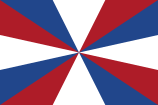 |
| Logo | |
| Aircraft flown | |
| Patrol | NH90 |
During the 17th century, the navy of the Dutch Republic (1581–1795) was the most powerful naval force in the world and played an active role in the Anglo-Dutch Wars, the Franco-Dutch War, and wars against Spain and several other European powers. The Batavian Navy of the later Batavian Republic (1795–1806) and Kingdom of Holland (1806–1810) played an active role in the Napoleonic Wars, though mostly dominated by French interests.
After the establishment of the modern Kingdom of the Netherlands, it served an important role in protecting Dutch colonial rule, especially in Southeast Asia, and would play a minor role in World War II, especially against the Imperial Japanese Navy. Since World War II, the Royal Netherlands Navy has taken part in expeditionary peacekeeping operations.
Bases
The main naval base is located at Den Helder, North Holland. Secondary naval bases are located at Amsterdam, Vlissingen, Texel, and Willemstad (Curaçao). Netherlands Marine Corps barracks are found in Rotterdam, Doorn, Suffisant on Curaçao, and Savaneta on Aruba.
Officer training
Officers of the Nederland Navy are trained at the Koninklijk Instituut voor de Marine ("Royal Naval Institute"), which is part of the Nederlandse Defensie Academie ("Netherlands defence academy") in Den Helder.[3] Around 100–150 people start training every year.
Ship prefixes
An international prefix for ships of the Royal Netherlands Navy is HNLMS (His/Her Netherlands Majesty's Ship).[4] The Netherlands navy itself uses the prefixes Zr.Ms. (Zijner Majesteits, His Majesty's) when a king is on the throne, and Hr.Ms. (Harer Majesteits, Her Majesty's) when there is a queen. This happens automatically at the moment of inauguration.[5]
History
The modern Netherlands Navy dates its founding to a "statute of admiralty" issued by Holy Roman Emperor Maximilian I on 8 January 1488.[6] Naval historians trace the origins of an independent Dutch navy to the early stages of the Eighty Years' War (1568–1648) while the formation of a "national" navy is dated to the establishment of the Dutch Republic in 1597.[7]
Netherlands Golden Age
.jpg)
The Netherlands navy was involved in several wars against other European powers from the late 16th century, initially for independence against Spain in European waters, later for shipping lanes, trade and colonies in many parts of the world, notably in four Anglo-Dutch wars against England. During the 17th century the Dutch navy was one of the most powerful navies in the world. As an organization, the navy of the Dutch Republic consisted of five separate admiralties (three of them in Holland, and one each in Friesland and Zeeland), each with its own ships, personnel, shipyards, command structures and revenues.[8]
World War II

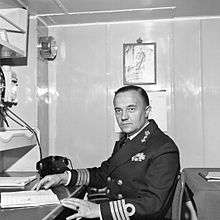
At the start of WW2 the Dutch had five cruisers, eight destroyers, 24 submarines, and smaller vessels, along with 50 obsolete aircraft. During the Second World War, the Dutch navy was based in Allied countries after the Netherlands was conquered by Nazi Germany in a matter of days: the Dutch navy had its headquarters in London, England, and smaller units in Ceylon (modern day Sri Lanka) and Western Australia.
Around the world Dutch naval units were responsible for transporting troops, for example during Operation Dynamo at Dunkirk and on D-Day, they escorted convoys and attacked enemy targets. During the war the navy suffered heavy losses, especially in defending the Dutch East Indies, most notably the Battle of the Java Sea in which the commander, Dutchman Karel Doorman, went down with his fleet along with 1,000 of the ships' crew. Two Dutch light cruisers and one destroyer leader and three destroyers that were under construction were captured in their shipyard by Nazi Germany.
During the relentless Japanese offensive of February through April 1942 in the Dutch East Indies, the Dutch navy in Asia was virtually annihilated, and it sustained losses of a total of 20 ships (including two of its three light cruisers) and 2,500 sailors killed.[9] The Dutch navy had suffered from years of underfunding and came ill-prepared to face an enemy with more and heavier ships with better weapons, including the Long Lance-torpedo, with which the cruiser Haguro sank the light cruiser HNLMS De Ruyter.[10]
A small force of submarines based in Western Australia sank more Japanese ships in the first weeks after Japan joined the war than the entire British and American navies together during the same period, an exploit which earned Admiral Helfrich the nickname "Ship-a-day Helfrich".[11] The aggressive pace of operations against the Japanese was a contributing factor to both the heavy losses sustained and the greater number of successes scored as compared to the British and Americans in the region.
Both British and American forces believed that the Dutch admiral in charge of the joint-Allied force was being far too aggressive. Later in the war, a few Dutch submarines scored some remarkable hits, including one on a Kriegsmarine U-boat U-95 in the Mediterranean Sea, which was sunk by O 21.
Netherlands New Guinea
After the war, the relations between the Netherlands and its colonies changed dramatically. The establishment of the Republic of Indonesia, two days after the Japanese surrender, thwarted the Dutch plans for restoring colonial authority. After four years of war the Netherlands acknowledged the independence of Indonesia.
Part of the Dutch Navy was next stationed in Netherlands New Guinea until that, too, was turned over to the Indonesian government in 1962. This followed a campaign of infiltrations by the Indonesian National Armed Forces, supported by modern equipment from the Soviet Union, that was nevertheless successfully repulsed by the Dutch navy. These infiltrations took place after the order of President Sukarno to integrate the territory as an Indonesian province.
NATO cooperation

With the creation of the North Atlantic Treaty Organisation, the military focus was on the army and air force; it was not until the Korean War (1950–53) that the navy got more recognition. The government allowed the creation of a balanced fleet consisting of two naval squadrons. Apart from the aircraft carrier HNLMS Karel Doorman the Dutch navy consisted of two light cruisers (two De Zeven Provinciën class), 12 destroyers (four Holland class, eight Friesland class), eight submarines, six frigates (van Speijk-class frigates), and a considerable number of minesweepers.
As a member of NATO, the Netherlands developed its security policy in close cooperation with other members. The establishment of the Warsaw pact in 1955 intensified the arms race between West and East. Technical innovations rapidly emerged, the introduction of radar and sonar were followed by nuclear weapon systems and long-range missiles. The geopolitical situation allowed for a fixed military strategy. Beginning in 1965, the Dutch Navy joined certain permanent NATO squadrons like the Standing Naval Force Atlantic.
Current structure

The constituent parts of the Royal Netherlands Navy are:
Naval squadron
Contains all surface combatants, replenishment ships, and amphibious support ships.
Submarine service
Contains the submarines and a support vessel.
Mine Detection and Clearing Service
Contains various minehunters.
Hydrographic Survey
The Dutch Hydrographic Service is responsible for relevant hydrographic surveys. (Dienst der Hydrografie).
Naval aviation
- Two helicopter squadrons
Netherlands Marine Corps
- One Marine Training Command (MTC) (formerly known as GOEM: Groep Operationele Eenheden Mariniers)
- Two Operational Marine Combat Groups (1 MCG AND 2 MCG)
- One Maritime Special Operations Force (NLMARSOF)
- One Surface Assault and Training Group (SATG)
- One Seabased Support Group (SSG)
- One rifle company (32 Raiding Squadron.)is permanently stationed at Aruba
Netherlands & Dutch Caribbean Coastguard
Although the Netherlands Coastguard is not an official part of the Navy, it is under its operational control. Also the Dutch Caribbean Coast Guard is under the operational control of the Navy and is commanded by the commander of the Navy in the Caribbean.
Equipment
Ships
The Royal Netherlands Navy currently operates 7 main classes of vessels:
- Note: in the Royal Netherlands Navy frigates are interchangeable with destroyers as there is no separate class
| Type ship | Defensenote 1974 | Defensenote 1984 | Priority Document 1993 | Navy study 2005 | Economize 2011 | Defensenote 2018 |
|---|---|---|---|---|---|---|
| LC frigates | 4 | 4 | 4 | |||
| M frigates | 4 [12] | 8 [13] | 8 | 2 | 2 | 2 |
| GW frigates | 2 | 2 | 2 | |||
| L frigates | 1 [14] | 2 | 2 | |||
| S frigates | 12 | 10 | 6 | |||
| MLM frigates [15] | 6 | |||||
| Frigates | 25 | 22 | 18 | 6 | 6 | 6 |
| Patrol ships | 4 | 4 | 4 | |||
| Submarine | 6 | 6 | 4 | 4 | 4 | 4 |
| Supply ships | 2 | 2 | 2 | 1 | 1 | |
| LPD | 1 | 2 | 2 | 2 | ||
| JSS | 1 | 1 | 1 | |||
| Minehunters | 15 | 15 | 15 | 10 | 6 | 6 |
| Minesweepers | 11 | 11 [16] | ||||
| Total ships | 59 | 56 | 40 | 28 | 23 | 24 |
| LRMP Aircraft | 21 | 13 [17] | 13 | |||
| Helicopters | 36 [18] | 30 [19] | 20 | 20 | 20 | 20 |
| Total aircraft | 57 | 43 | 33 | 20 | 20 | 20 |
* The Royal Netherlands Navy classifies the De Zeven Provinciën-class as frigates, but internationally they are most comparable to destroyers (due to their size and weapon capability) platform for Sea Based Anti-Ballistic Missile defence
Naval aviation – maritime helicopters
- 20 NH90, 12 NATO Frigate Helicopter (NFH) and eight transport version of the NATO Frigate Helicopter (TNFH) for Marine Corps Air Lift Helicopter Squadron [20]
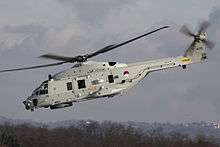
In 2012 an Apache attack helicopter from the Royal Netherlands Air Force made a deck landing on board HNLMS Rotterdam for the first time as part of an initial study into the possibilities for wider use of the helicopters as these will be upgraded to the AH-64E standard which has specific features for maritime operations.
The Dutch amphibious support ship HNLMS Johan de Witt and the HNLMS Karel Doorman JSS are designed to handle Royal Netherlands Air Force CH-47F Chinook helicopters but still require additional anti corrosion measures (part of the ongoing upgrade of the CH-47F).
Unmanned vehicles
Armored vehicles (Marine Corps)
- 156 BV206S armored all-terrain personnel carriers (127 will get a Mid-Life Update, the rest will be disposed of or sold)
- 74 BVS10 armored all-terrain personnel carriers
- 20 Bushmaster Mine-Resistant Ambush Protected
- 4 Leopard 1 BARV beach armored recovery vehicles
Unarmored vehicles (Marine Corps)
- Iveco LMV-2 AFV's on order
- Land Rover Defender
- 40 Iveco Daily ANACONDA Special Purpose vehicles (Based at Caribbean Stations)
- 40 Mercedes-Benz 280 CDI
- Unimog 1.2-ton truck
- Various DAF & Scania trucks
Artillery (Marine Corps)
- L16A2 81 mm mortar
- M6 C-640 – 60 mm commando mortar
Personal weapons
- Colt Canada C7NLD – 5.56×45mm NATO assault rifle
- Colt Canada C8NLD – 5.56×45mm NATO carbine
- Heckler & Koch HK416 – 5.56×45mm NATO carbine
- Glock 17M – 9×19mm Parabellum semi-automatic pistol (the M in Glock 17 stands for Maritime)
- FN MAG – 7.62×51mm NATO general purpose machine gun
- M2HB-QCB – .50 BMG heavy machine gun
- Accuracy International AWM – .338 Lapua Magnum sniper rifle
- Barrett M107 – .50 BMG anti-materiel sniper rifle
- Heckler & Koch MP5 – 9×19mm Parabellum submachine gun
- FN P90 – 5.7x28mm submachine gun
- Mossberg M590A1 – 12 gauge shotgun
- Panzerfaust 3 – anti-tank weapon
- GILL – anti-tank missile
Current inventory
In 2019 the fleet of the Royal Netherlands Navy consists of these ships:
| Class | Photo | Type | Number | Dates | Details |
|---|---|---|---|---|---|
| Walrus class | 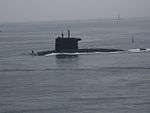 | Submarine | 4 | 1994 | Multi-purpose diesel-electric powered hunter-killer submarines for deep ocean, brown water & special forces operations. SLEP 2015–2019, will be replaced by 4 new subs from 2027 onwards.[22] |
| De Zeven Provinciën class | .jpg) | Frigate | 4 | 2002 | Mainly anti-air warfare with BMD capability, ASW and with extensive command & communication facilities. |
| Karel Doorman class | .jpg) | Frigate | 2 | 1994 | 8 initially built for the Royal Netherlands Navy, pairs of ships subsequently sold to the Belgian, Portuguese and Chilean navies. Belgian and Dutch M-Class frigates recently received extensive upgrades such as an extended helicopter deck and new advanced sensors and improvements in stealthiness. Will be replaced in 2028-29. |
| Holland class |  | Offshore patrol vessel | 4 | 2011 | Ocean patrols |
| Alkmaar class | 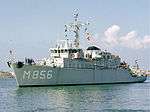 | Minehunter | 6 | 1989 | Initial class of 15 ships, will be replaced starting 2027 |
| Karel Doorman class | 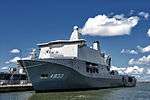 | Joint logistic support ship | 1 | 2014 | Combined amphibious operations/seabased helicopter platform & fleet replenishing, capable of supporting CH-47/AH-64/NH-90 operations |
| Rotterdam class | .jpg) | Landing platform dock | 2 | 1998/2007 | Troop & equipment transport, helicopter platform with command & communication & hospital facilities |
| Cerberus class | 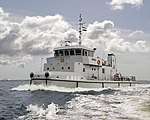 |
Diving support vessel | 4 | 1992 | Multi-purpose diving support vessels & harbour protection |
| Soemba class |  |
Diving support vessel | 1 | 1989 | Multi-purpose diving support vessels & harbour protection |
| Pelikaan class |  |
Multi-purpose logistic support vessel | 1 | 2006 | Multi-purpose logistic & amphibious support vessel based in Dutch Caribbean |
| Mercuur class | 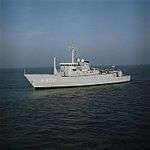 |
Submarine support vessel | 1 | 1987 | Submarine support vessel & MCM command, upgraded in 2017 |
| Snellius class |  | Hydrographic survey vessel | 2 | 2004 | Multi-purpose hydrographic survey vessel |
The total tonnage will be approx. 140,000 tonnes. Next to these ships a lot of other smaller vessels remain in the navy.
With these changes the Royal Netherlands Navy will have 10 large oceangoing vessels ranging from medium/low to high combat action ships. The renewed Dutch Navy will be a green-water navy, having enough frigates and auxiliaries to operate far out at sea, while depending on land-based air support, and, with the large amphibious squadron, they will have significant brown-water navy capabilities.
Future changes
In January 2020 women were allowed to join submarine crews in the Royal Netherlands Navy for the first time.[23]
In April 2018, the Dutch Government approved a multi-year investment program and allocated funds for the 2018–2030 period, including;
- The Walrus-class submarines replacement with all replacement boats planned for service entry between 2027 and 2031. The sub's are currently undergoing a Service-life Extension Program (SLEP), including new sonar, new optronic periscope and weapon upgrades for near shore operations. The Royal Dutch Navy is evaluating Saab/Damen (A-26), TKMS (Upgraded 212), Navantia S-80 and a Naval Group (SSK version of Barracuda) proposal. In 2019 the S-80 option was dropped with plans to place an order for the winning design in 2022.[24][22]
- Upgrading the De Zeven Provinciën-class LCF frigates Theatre Ballistic Missile Defense, acquisition of SM-3 missiles, a new OtoMelara 127/64 LW canon, ESSM-2 and SLCM integration 2018–2021 with a planned replacement from 2028 onwards.
- Replacement of the Karel Doorman-class M frigates in the 2028/29 period by 2 ships[25](plus another 2 for the Belgian Navy), designed & build by Damen Shipyards.[26] See Future Surface Combatant for more information.
- Replacement of the 6 Alkmaar-class MCM ships from 2024 including MCM Drones. 6 units will be built for both the Belgian and Dutch navies with a total of 12 ships.[26] The contract was won by Naval Group on 15 March 2019.[27][28]
- Increasing the size of the Royal Netherlands Marine Corps to remain highly integrated with the British Royal Marines. In 2017 the Ministry of Defence announced the formation of a Fleet Marine Squadron for the protection of merchant ships.
- The German Navy Seebatallion (Marines) will be integrated into the Royal Netherlands Marine Corps.
- Cooperation with the German Navy regarding Submarine & Amphibious Operations.
- Acquisition of a new Combat Support Ship to replace the former Zr.Ms. Amsterdam, designed & build by Damen Shipyards.[29] This ship will be based on the JSS Karel Doorman design to improve type commonality (architecture & components) and is expected to be delivered in 2024.[30] The ship will be named Zr.Ms. Den Helder after the city of Den Helder, with the pennant A834.
- Replacement of Zr.Ms. Mercuur, Zr.Ms. Pelikaan, the four diving support vessels, the diving training vessel Zr.MS. Soemba, the hydographic vessels Zr.Ms. Snellius en Zr.Ms. Luymes and the training vessel Van Kinsbergen from 2024 onwards.
- Acquisition of new LCU's in 2025 with additional capacity to support amphibious operations and the integration of the German Navy Marines (Seebatallion).
- Main Naval Ship Based Weapons will be replaced by acquiring ESSM-2, new 127mm canons, Harpoon ASuW replacement, SM-3, SM-2 IIIC SAM, Goalkeeper CIWS replacement, MK 46 & MK 48 Torpedo replacement and SLCM (study).
Theater ballistic missile defense
Together with the United States and several other NATO members, the Dutch Navy is testing and updating its ships for Tactical ballistic missile defense capability. Although tests conducted concerning the capability of the APAR (Active Phased Array Radar) have been very successful, in 2018 the Dutch Government approved plans to acquire the SM-3 missiles for integration into the existing weapon suite of the LCF frigates. The four LCF ships will be fitted out with eight SM-3 missiles each (they are provisioned for this VLS extension) through Foreign Military Sales (under discussion between the US and The Netherlands).
Gallery
 HNLMS Rotte, coastal tugboat
HNLMS Rotte, coastal tugboat HNLMS Urania, sail training ship
HNLMS Urania, sail training ship HNLMS Nautilus, dive support vessel
HNLMS Nautilus, dive support vessel.jpg) HNLMS Mercuur, torpedo recovery vessel
HNLMS Mercuur, torpedo recovery vessel Landing Craft Utility MKII NL
Landing Craft Utility MKII NL
Historic ships
- several ships by the name of HNLMS De Ruyter
- several ships by the name of HNLMS Tromp
- Delft, 18th century fourth rate ship of the line
- De Zeven Provinciën, 17th century ship of the line and flagship of Michiel de Ruyter
- HNLMS Koning der Nederlanden, the navy's largest warship in the 19th century
- HNLMS Prins Hendrik der Nederlanden, ironclad from the 1860s
Surviving historic ships
By period
Ranks and insignia
Officers
| NATO code | OF-10 | OF-9 | OF-8 | OF-7 | OF-6 | OF-5 | OF-4 | OF-3 | OF-2 | OF-1 | OF(D) | Student officer | ||||||||||||||||||||||||
|---|---|---|---|---|---|---|---|---|---|---|---|---|---|---|---|---|---|---|---|---|---|---|---|---|---|---|---|---|---|---|---|---|---|---|---|---|
(Edit) |
No equivalent |  |
 |
 |
 |
 |
 |
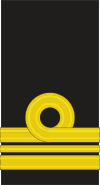 |
 |
 |
 |
Adelborst/Korporaal-Adelborst/Sergeant-Adelborst | No equivalent | |||||||||||||||||||||||
| Luitenant-Admiraal | Vice-Admiraal | Schout-bij-Nacht | Commandeur | Kapitein ter zee | Kapitein-luitenant ter zee | Luitenant ter zee der 1ste klasse | Luitenant ter zee der 2de klasse oudste categorie | Luitenant ter zee der 2de klasse | Luitenant ter zee der 3de klasse | |||||||||||||||||||||||||||
| Abbreviation (stnd) | LAdm | VAdm | SBN | Cdr | KTZ | KLTZ | LTZ1 | LTZ2OC | LTZ2 | LTZ3 | Adb | |||||||||||||||||||||||||
Enlisted ranks
| NATO Code | OR-9 | OR-8 | OR-7 | OR-6 | OR-5 | OR-4 | OR-3 | OR-2 | OR-1 | |||||||||||||||||||||||||||
|---|---|---|---|---|---|---|---|---|---|---|---|---|---|---|---|---|---|---|---|---|---|---|---|---|---|---|---|---|---|---|---|---|---|---|---|---|
(Edit) |
 |
 |
 |
 |
 |
 |
 | |||||||||||||||||||||||||||||
| Adjudant onderofficer/ Opperschipper (deckservice) |
Sergeant-majoor/ Schipper (deckservice) |
Sergeant/ Bootsman (deckservice) |
Korporaal/ Kwartiermeester (deckservice) |
Matroos/ Marinier der 1e klasse |
Matroos/ Marinier der 2e klasse |
Matroos/ Marinier der 3e klasse | ||||||||||||||||||||||||||||||
See also
References
- "Aantallen personeel". defensie.nl (in Dutch). 1 July 2019. Retrieved 27 May 2020.
- "The Royal Netherlands Navy in Focus". Government of the Netherlands. November 2015. Retrieved 5 September 2019.
- "Koninklijk Instituut voor de Marine". defensie.nl. 13 February 2014. Archived from the original on 24 May 2016. Retrieved 25 May 2016.
- "List of Acronyms Preceding the Name of a Ship". Corporation of Lower St. Lawrence Pilots. Archived from the original on 6 July 2011. Retrieved 31 July 2013.
- "Defensieschepen worden meteen Zr. Ms. in plaats van Hr. Ms" (in Dutch). Volkskrant. 29 January 2013.
- "Geschiedenis marine". defensie.nl. Archived from the original on 28 March 2016. Retrieved 25 May 2016.
- Jaap R. Bruijn, "Dutch Navy" in Bruce, Anthony & Cogar, William (editors) An Encyclopedia of Naval History. Facts on File, New York. 1998; p. 121
- Rodger, N. A. M. (2004) Command of the Ocean: A Naval History of Britain 1649–1815. Penguin Books, London; pp. 9–10
- Klemen, L (1999–2000). "The War at Sea". Forgotten Campaign: The Dutch East Indies Campaign, 1941–1942. Archived from the original on 5 March 2012. Retrieved 3 June 2011.
- Dr. L. de Jong, Het Koninkrijk der Nederlanden in de Tweede Wereldoorlog (Dutch), 14 parts, part 11a-I-second half, RIOD, Amsterdam, 1975
- "World Battlefronts: Dutchman's Chance". Time. 23 February 1942. Archived from the original on 25 October 2011. Retrieved 3 June 2011.
- De M-fregatten werden voor het eerst genoemd bij de Memorie van Toelichting bij de defensiebegroting van 1977.
- In de defensienota 1984 ging het om een groter type M-fregat dan in de MVT 1977 nog sprake was.
- Het Aangepast Standaardfregat, zoals genoemd in de Defensienota van 1974 was een iets groter schip dan de uiteindelijk gebouwde L-fregatten
- Gemoderniseerde Van Speijkklasse
- Gepland was tevens de aanschaf van 2 oceaanmijnenvegers, maar een jaar later was dit plan al geschrapt. Gepland was voorts de vervanging van de Dokkumklasse mijnenvegers vanaf 1988, met een nader te bepalen aantal van minimaal 6 en maximaal 15 mijnenvegers.
- Aanvankelijk werd de aanschaf van 2 extra Orion P-3 vliegtuigen overwogen, maar een jaar later waren deze plannen al geschrapt.
- Er is later zelfs nog aan 40 helikopters gedacht.
- Gepland was de aanschaf van 8 grote helikopters, als aanvulling op de 22 (2 waren al verloren gegaan) Lynx helikopters van de MLD.
- "Royal Netherlands Navy Takes Delivery of a Mission Planning System for the NH90 NFH Fleet". 29 November 2013. Archived from the original on 3 December 2013. Retrieved 30 November 2013.
- "RNLN Integrates SeeByte's Neptune into its AUVs". marinetechnologynews.com. Marine Technology News. 28 September 2018. Archived from the original on 2 April 2019. Retrieved 2 April 2019.
- Gain, Nathan (8 November 2019). "Another short delay for the Dutch Navy Walrus-class submarine replacement program".
- Gain, Nathan (22 January 2020). "Dutch female sailors now admitted for submarine service". Naval News. Retrieved 1 May 2020.
- Kuper, Stephen (10 January 2020). "Dutch Navy confirms three corner fight for future sub program". www.defenceconnect.com.au.
- https://www.navalnews.com/naval-news/2020/06/dutch-mod-clears-path-for-the-m-frigates-replacement-expects-delays/
- Marine krijgt nieuwe schepen, Dutch Ministry of Defence, 3 May 2018, archived from the original on 3 May 2018, retrieved 3 May 2018
- "France's Naval Group clinches Belgian-Dutch minehunter replacement contract". Naval Today. 15 March 2019. Archived from the original on 15 March 2019. Retrieved 15 March 2019.
- Scott, Richard (15 March 2019). "Naval Group team selected for BE/NL MCM programme". Jane's 360. London. Archived from the original on 15 March 2019. Retrieved 15 March 2019.
- Karremann, Jaime. "Marine wil bevoorrader 'in de geest van Zr.Ms. Amsterdam'". marineschepen.nl. Archived from the original on 22 February 2018. Retrieved 22 February 2018.
- Karremann, Jaime. "Nieuw bevoorradingsschip komt in 2022". marineschepen.nl. Archived from the original on 22 February 2018. Retrieved 22 February 2018.
External links
| Wikimedia Commons has media related to Royal Netherlands Navy. |
- Official website
